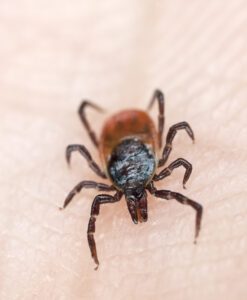 Lyme disease is caused by the bacterium Borrelia burgdorferi, which is transmitted through a bite from an infected blacklegged tick. If a blacklegged tick has bitten you you are at risk for developing Lyme disease.
Lyme disease is caused by the bacterium Borrelia burgdorferi, which is transmitted through a bite from an infected blacklegged tick. If a blacklegged tick has bitten you you are at risk for developing Lyme disease.
Symptoms generally include fatigue, headache, fever, and a skin rash. If Lyme disease is left untreated the infection may spread to the heart, nervous system and joints. It’s very important to get medical attention if you think you have Lyme disease. Treatment is available and generally only takes a few weeks of antibiotics to recoup.
Is Lyme Disease More Common Than Often Assumed?
Every year, around 30,000 cases of Lyme disease are reported to the Centers for Disease Control and Prevention (CDC). New reports have come out stating the actual numbers of people with Lyme disease are much higher.
Research combining cases reported to the CDC with field research, insurance claims, public surveys and data from clinical laboratories state the numbers are closer to 300,000 Americans diagnosed with tick-borne disease every year. This means that Lyme disease is far more prevalent in the US than it has been given credit for in past years.
What Is Zoonotic Disease?
A zoonotic disease is any disease passed from animals to humans, and Lyme disease is classified as such. The same bacterium that causes Lyme disease is also present in mice and deer. When blacklegged ticks feed on infected animals they become a carrier capable of passing the disease along to humans through one bite.
Some people are genetically equipped to fight off Lyme disease before it spreads and causes infection. Others lack the genetic makeup to do so, and as a result the disease spreads into a more potent infection.
How To Prevent Lyme Disease
Knowing how to prevent Lyme disease is your best line of defense; all you have to do to is avoid being bit by a tick. Thankfully, most tick bites are fairly preventable.
Protect yourself against tick bites by:
- Stay out of areas where ticks thrive, such as thick brush or high grass near wooded areas.
- Wear light colored clothing so that it’s easier to see a tick on your clothing before it has a chance to reach your skin and bite.
- If you are out walking the trails or near tick-infested areas, tuck your pants inside of your socks. You might look a little silly but a tick won’t bite you! Ticks tend to attach to the bottom of pants, making it easy for them to get inside of your clothes and make a snack out of your legs and ankles before you even notice they are there.
- Stick to well-worn paths where ticks have less hiding places in brush and debris.
- Keep lawn furniture and children’s toys in the sun as opposed to overly shaded areas. Ticks don’t do well in the heat and prefer to hang out in areas that are very shady and secluded from the sun and light.
- Always check you, your children and pets for ticks. The sooner you remove a tick the less chance you have of contracting Lyme disease.
How To Remove A Tick
If you need to remove a tick you want to do so properly in order to prevent worsening the problem. The proper way to remove a tick as advised by the CDC:
- Use tweezers with a fine tip and grasp the tick as close the surface of the skin as possible.
- Apply steady, even pressure as you pull up on the tweezers. Be careful not to move around the tweezers too much or else you risk pulling the tick body off and leaving the head still attached inside.
- Once the tick is completely removed, wash and sanitize the area with rubbing alcohol, iodine scrub, or soap and water.
- Never crush a tick! Instead you want to get rid of it by placing it in a sealed bag or container, in a glass of alcohol, or flushing it down the toilet.
There is an old rumor that you can apply Vaseline to the end of the tick to kill it and then wait for it to release its grip and fall out. This is not advised; instead the goal is to remove the tick as soon as possible as opposed to waiting for it to fall off.
Diagnosing Lyme Disease
Lyme disease is often diagnosed through physical appearance of symptoms and risk factors related to being bit by an infected tick. Laboratory testing can also be conducted if necessary to make a diagnosis.
If you feel sick, and/or have a fever or a rash within a few weeks of removing a tick visit your local Urgent Medical Center right away.




